Witches and Tarot: A Deep Dive into Their Connection
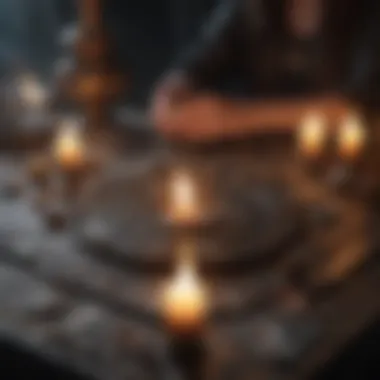
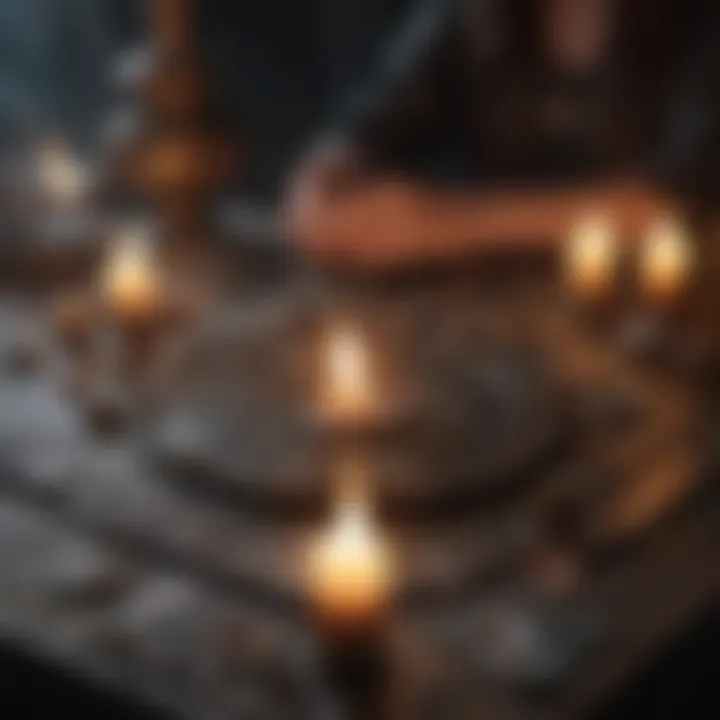
Intro
The bond between tarot and witchcraft is a tapestry woven through centuries, filled with threads of mysticism, tradition, and self-discovery. Both practices draw from a rich historical backdrop, evolving alongside societal norms and personal beliefs. This article navigates through this fascinating intersection, revealing how tarot cards serve not just as a divination tool, but also as a mirror reflecting the inner workings of the witch's mind.
Witches, historically shrouded in myth and sometimes misunderstood, have long utilized various forms of divination to gain insight into their lives and the world around them. In this exploration, we will uncover the ways in which tarot acts as a conduit for witches, aiding them in their practices, and enhancing their intuitive abilities.
"The cards are not just about predicting the future; they are about understanding the self."
This article will further examine the symbolic meanings embedded in tarot, going beyond the surface to unearth the deeper implications of each card and its connection to diverse spiritual practices. Through a blend of historical context and modern applications, we intend to provide a comprehensive understanding of how this powerful duo informs contemporary spiritual journeys.
Historical Context of Witches and Tarot
Understanding the historical context of witches and tarot is essential to grasp the rich tapestry interwoven between these two subjects. The evolution of witchcraft and tarot not only mirrors societal beliefs and fears but also illustrates how practices believed to be mystical or occult can deeply influence personal growth and understanding. By delving into this history, we uncover layers that reveal how these paths connect and diverge, giving modern practitioners a clearer sense of identity and purpose.
Origins of Witchcraft
Witchcraft, as an idea, stretches back into antiquity, where early practitioners often aligned themselves with nature and used herbs, chants, and rituals to heal or harm. This craft was closely tied to the earth, reflecting the cycles of life and death, and those who practiced it were often seen as custodians of ancient wisdom. The term 'witch' itself has roots in the Old English word "wicce," which translates to a female practitioner of magic and showcases an element of duality—the nurturing and the feared.
In times past, societies revered witches for their roles as healers. They not only provided remedies using medicinal plants but also served as mediators between the spiritual and the material worlds. However, this veneration flipped on its head during periods like the European witch hunts, where societal fears manifested in violent consequences. Women accused of witchcraft were often scapegoated for societal troubles: crop failures, disease, or even personal grievances. Thus, the history of witchcraft forms a narrative filled with irony—once a source of knowledge, it became tethered to guilt and suspicion.
"Witchcraft caught between the pendulum of reverence and fear exposes the fragility of societal perceptions."
The Development of Tarot Cards
In contrast, tarot cards trace their heritage to 15th-century Italy, originating as playing cards. The tarot deck, as we know it, developed over centuries, revealing insights into culture's changing values and philosophies. Initially, tarot was used for games, but by the 18th century, it began to garner an aura of spiritual significance. Notably, figures like Antoine Court de Gébelin advanced the concept of tarot as a mystical tool, associating it with ancient Egyptian wisdom and kabbalistic traditions.
Tarot cards consist of two main suits: the Major Arcana and the Minor Arcana. The Major Arcana embodies significant life themes, while the Minor Arcana delves into day-to-day experiences. Each card is steeped in symbolism, making the tarot not simply a deck, but rather a tool for reflection and interpretation. This transformation from a mere game to a spiritual compass highlights how tarot has evolved while retaining a unique character, allowing for individual exploration of complex life questions.
The Confluence of Witchcraft and Tarot
As these paths developed, they inevitably crossed. The convergence of witchcraft and tarot signifies a shared pursuit of understanding oneself and the universe. For many witches, tarot became a vital part of their practice. The cards provide insights during rituals, tapping into intuition and revealing hidden truths. This practice aligns seamlessly with the core philosophies of witchcraft, wherein the individual seeks to connect with deeper energies.
The contemporary witch often incorporates tarot readings as a means of divination, bridging the mundane and the mystical. The process is not only spiritual; it also serves as a psychological tool for self-discovery. By interpreting the symbols and narratives within the cards, practitioners forge deeper connections with their inner selves and the wider world.
The Symbolism of Tarot in Witchcraft
The significance of symbolism in tarot when it comes to witchcraft is immense. It provides the foundation for deep exploration of self, the universe, and the intricate dance between the two. This intersection brings forth a rich tapestry of imagery and meanings, allowing practitioners to tap into inner wisdom and the energies surrounding them. Understanding these symbols can greatly enhance one's practice, drawing connections that can lead to profound insights and personal growth.
Major Arcana: Key Archetypes
The Major Arcana is often seen as the heart and soul of the tarot deck. Comprising 22 cards, each one serves as a vessel of powerful archetypal energies. For witches, these bring forth iconic figures like The Fool and The Magician, who represent the journey through life and the manifestation of desires, respectively.
- The Fool embodies new beginnings, innocence, and the adventures that are yet to come. This archetype resonates with the witch's pursuit of knowledge and exploration of the unknown.
- The High Priestess, symbolizing intuition and the subconscious mind, is a guide for those seeking deeper insights into their own potentials.
- The Death card, often misunderstood, signals transformation and the end of cycles. In witchcraft, it reinforces the idea that endings can lead to new beginnings, mirroring the cyclical nature of life itself.
Each of these archetypes encapsulates lessons and experiences that witches can relate to on both a personal and spiritual level. They serve as a reminder of the journeys undertaken, the challenges faced, and the growth that can emerge from both light and dark aspects of life.
Minor Arcana: Everyday Influences
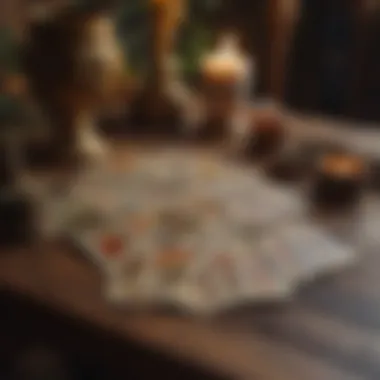
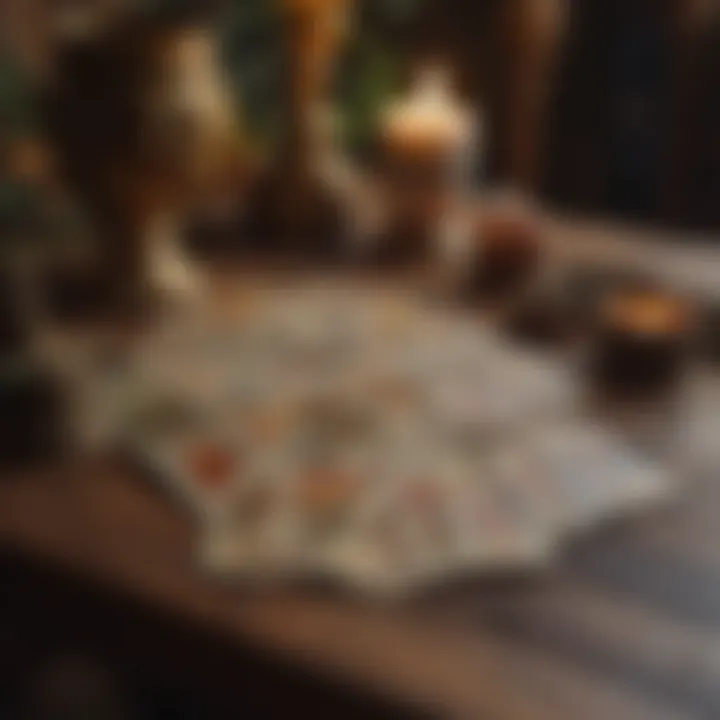
While the Major Arcana focuses on the monumental moments in life, the Minor Arcana brings the day-to-day experiences into light. These cards, divided into four suits—Cups, Wands, Swords, and Pentacles—represent the different facets of existence, encapsulating the mundane and the extraordinary.
- Cups relate to emotions, relationships, and connections, crucial for witches who seek harmony and emotional balance in their lives.
- Wands symbolize spirituality, action, and creativity, encouraging practitioners to embrace their innate powers.
- Swords denote thoughts, challenges, and conflicts. For a witch, this can be a reminder of the importance of mental clarity in manifesting intentions.
- Pentacles connect to material aspects and stability, emphasizing the need for groundedness and practical application of one’s craft.
The Minor Arcana thus reflects a witch's everyday life and decisions. Being aware of these influences through tarot can guide practitioners, helping them navigate through daily hurdles while embracing their spiritual journey.
Color and Numerology in Tarot
Another layer of depth in tarot is the significance of color and numerology, both of which can amplify the understanding of a reader’s personal connection to the cards.
- Color in tarot is not just aesthetic; it carries meaning. For instance, red often indicates passion and action. Green might point to growth and fertility. Each hue serves to enrich the narrative told by the cards, bringing forth nuances and emotional depth during readings.
- Numerology also plays a pivotal role. The number associated with each card adds another dimension of interpretation. For example, the number 1 represents beginnings and potentials, resonating well with the themes present in The Magician card. Conversely, the number 10 often highlights completion and resolution, pertinent to the insights gained from the Wheel of Fortune.
By weaving together the layers of color and numerology with the imagery of the tarot, witches can gain deeper comprehension of their readings, enabling a richer dialogue with their own personal experiences and the universe at large.
"The symbols within tarot act as keys; unlocking our understanding of the self and the world."
Through the realm of symbolism, witchcraft practitioners can fully embrace the diverse and intricate meanings embedded within the tarot. This understanding cultivates personal growth and deeper insights into one’s own path, ensuring that the magic is not only in the cards but within the reader themselves.
Practical Applications of Tarot in Witchcraft
The intertwining of Tarot and witchcraft creates a rich tapestry of practical applications that empower those who seek to harness their wisdom. Tarot serves not just as a tool for divination but as a companion in a witch's journey toward self-discovery and spiritual growth. The significance of incorporating tarot into witchcraft lies in its ability to illuminate paths, guide decisions, and enhance intuitive skills. These applications transcend mere card interpretations; they embody a holistic approach to aligning one’s inner world with the energies of the universe.
Daily Tarot Practices
Incorporating tarot into everyday routines can be a transformative practice for witches. This can start simply: a morning tarot pull to set the tone for the day. Drawing a single card in the morning helps cast a glimpse into potential energies or challenges that may arise. It allows witches to consciously engage with their day, turning mundane routines into sacred rituals. Consider keeping a journal dedicated to these daily pulls. Writing down reflections on how the drawn card played out can cultivate a deeper understanding over time.
- Journal Practice: Write about the card drawn and reflect on its meanings.
- Meditation: Spend a few minutes visualizing the card, allowing its energy to inform your mind and body.
By making tarot a part of daily life, it's as if you carry a magical anchor throughout your day, reminding you of your intentions and insights.
The Role of Tarot in Rituals
Tarot plays a central role in many witchcraft rituals, enhancing the group's collective energy and focus. It can be integrated into various practices, from full moon circles to individual spell workings. A tarot spread may be laid out during a ritual to gain clarity on intentions, allowing participants to connect with their inner guides.
Moreover, using tarot cards as focal points during spellcasting is quite common. For instance, pairing a card that emphasizes abundance, like The Empress, with a prosperity spell can amplify the desired outcome. This connection fosters a bridge between the physical items used in the craft and the energetic blueprint represented by the cards.
- Cleansing Cards: Before use, many witches will cleanse their tarot decks by smudging them with sage or placing them under the moonlight.
- Themed Rituals: During specific moon phases, tailored tarot readings can guide intentions related to that period; for example, release rituals could incorporate the Death card for transformation.
The essential aspect of using tarot in rituals is the synergy it creates between intention and intuition, enhancing the power of the work being done.
Intuitive Readings for Personal Insight
Beyond structured readings and spreads, intuitive readings are where the magic truly unfolds. This approach moves away from strict interpretations and leans heavily on the resonance of the cards with the reader’s gut instincts. Witches often find themselves tapped into their higher selves when engaging with tarot in this way.
Intuitive readings can lead to profound insights about personal challenges, relationships, and even spiritual paths. Instead of solely relying on traditional meanings, practitioners will often depict narratives based on the characters and symbols illustrated in the card imagery. This personal interpretation can surface hidden thoughts or feelings, making space for healing.
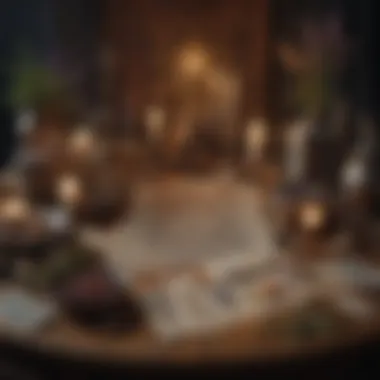
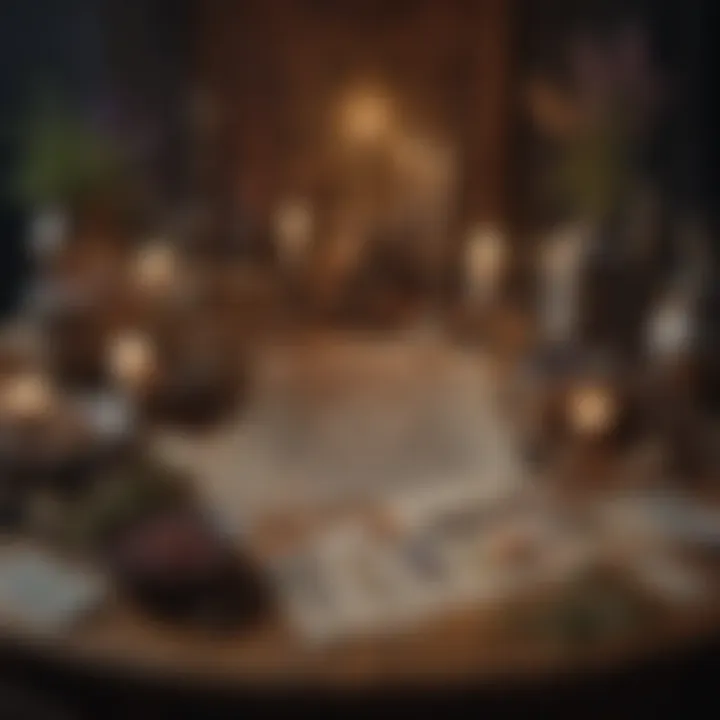
"Intuition is the compass guiding us through the murky waters of uncertainty, and tarot acts as the map."
To refine this practice, consider:
- Quiet Reflection: After laying out your cards, take a moment to breathe deeply and listen to your inner voice before diving into meanings.
- Dialogue with the Cards: Imagine conversing with each card; what story do they tell you? What emotions do they evoke?
Utilizing tarot for intuitive insights not only empowers the witch but also deepens their connection to the self and the universe.
In summary, embedding tarot into the fabric of witchcraft practices brings layers of depth, intention, and clarity. From daily engagements and ritual enhancements to intuitive explorations, tarot stands as a testament to the rich potential of these ancient arts.
Cultural Perspectives on Witches and Tarot
Cultural perspectives offer a rich tapestry through which to view the interplay between witches and tarot. This understanding not only affirms the adaptability of these traditions but also highlights their resonance across varied societies. By peering through different cultural lenses, one finds diverse interpretations of witchcraft and tarot, each steeped in historical significance and societal values. For many practitioners, this is more than mere fascination; it is about embracing a multifaceted connection to heritage, spirituality, and identity.
Tarot Traditions Across the Globe
Tarot is not a one-size-fits-all endeavor. Different regions have cultivated unique tarot practices that embody local customs, beliefs, and aesthetics.
- European Origins: The roots of tarot can largely be traced back to European card games. The Tarot de Marseille from France exemplifies how these cards evolved, morphing from recreational use to tools of divination. Its imagery often reflects French cultural symbols and societal norms of the time.
- Italian Influence: In Italy, tarot is seen not only as a divination tool but also as a form of art. The Visconti-Sforza deck, one of the oldest surviving tarot decks, is steeped in historical grandeur and artistry, representing the familial lineage and their power dynamics.
- Indian Tarots: In a completely different vein, India presents tarot through the lens of its rich spiritual and astrological heritage. Indian tarot often incorporates elements of Hindu mythology, making it a unique blend of culture and divination.
- Modern Adaptations: Today's tarot decks go beyond tradition, reflecting contemporary issues like feminism, ecology, and multiculturalism. Decks such as The Wild Unknown echo the individualist yearnings of a modern, global society, showcasing the ever-evolving nature of tarot.
The Evolution of Witch Archetypes
Witches, once pigeonholed as malevolent figures in folklore and society, have traversed a winding path of revaluation over centuries. The archetypes of witches have transformed significantly, shaped by cultural dialogues and societal upheavals.
- Historical Context: In the Middle Ages, witches were often associated with criminality, marked by superstition and fear. During the witch hunts, they were the scapegoats for social disturbances, accused of malice and harm. This historical narrative created a negative stereotype that lingered for ages.
- Renaissance and Beyond: As we moved into the Renaissance, aspects of witchcraft were romanticized, with new archetypes emerging, such as the wise woman or healer. This shift was influenced by literature and art, where witches began to be depicted with more nuance and depth, highlighting their wisdom and connection to nature.
- Modern Witchcraft: In recent years, the archetype of the witch has experienced yet another resurgence. Today's witches often embody empowerment, connection to the earth, and feminist ideals. Movements like Wicca and Eclectic Witchcraft promote a new lens through which to view the witch, focusing on personal agency and community.
The melding of tarot and these evolving archetypes fosters a deeper connection, inviting practitioners to see themselves not just as observers, but as active participants in a rich, ongoing dialogue of tradition and transformation.
Psychological Dimensions of Tarot Reading
The realm of tarot reading extends far beyond mere fortune-telling; it delves into psychological explorations of self-awareness, emotional well-being, and the complexities of our inner worlds. Understanding the psychological dimensions of tarot reading enhances not only the practice itself but also the potential transformation it can inspire. As tarot enthusiasts—we often seek more than just predictions; we crave a deeper connection with the self and the cosmos.
Within this section, we will explore two pivotal aspects: the path of self-understanding through the symbolic nature of the cards and how tarot fosters insight into the often-unacknowledged parts of our psyche.
Understanding the Self Through Cards
Tarot cards serve as mirrors reflecting our experiences, fears, and aspirations. Each card encapsulates a unique narrative that resonates with our personal story, enabling a dialogue with our subconscious mind. The imagery and symbols found in tarot invite introspection and encourage us to examine the core of our being.
Consider this: when you draw the Two of Swords, you are faced with a decision, symbolizing indecision and the need for balance. Here, the card doesn’t predict a specific event but rather nudges you to reflect on your current mental state. What choices are you avoiding? How do you feel about these choices?
Engaging with tarot allows individuals to access their intuition. This is the bridge to self-understanding, facilitating a confrontation with one’s true self. As we decipher the meanings behind various cards, we unearth patterns in our thoughts and actions. This self-discovery process not only guides decision-making but also fosters a sense of empowerment that propels us forward.
Tarot as a Tool for Shadow Work
Often, the most challenging journeys within ourselves are those that encourage us to face our shadow—the aspects of ourselves that we prefer to ignore or hide. Shadow work, as it is known, is integral to any psychological growth. Tarot provides a safe space to explore these darker facets without judgment.
For example, the Death card, often misunderstood as a harbinger of doom, in reality, symbolizes transformation and the end of cycles, urging one to confront fear of change. To engage with this card is to accept that what we resist typically holds the key to our growth.
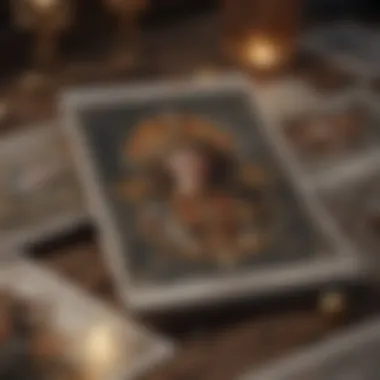
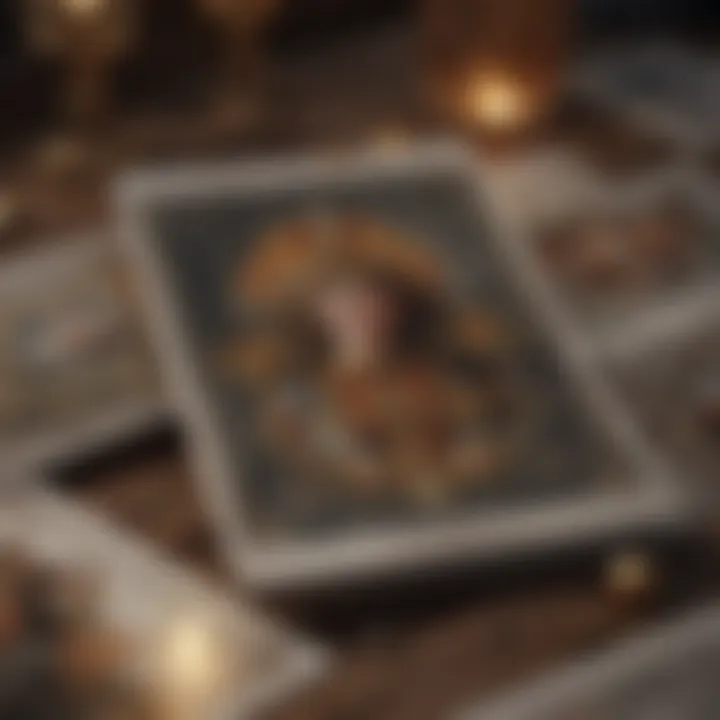
Incorporating tarot into shadow work can be beneficial for emotional healing and personal development. By laying out cards, you visualize and confront traumas or negative beliefs, making them more manageable. Here are some methods practitioners use:
- Card Spreads: Use specific spreads designed to uncover hidden aspects of self, focusing on acknowledgment and acceptance of one’s shadow.
- Journaling: Document thoughts and feelings evoked by each session. This can help clarify insights gained during readings.
- Meditation: Meditate on a chosen card, allowing its energy and symbolism to guide your reflection on suppressed emotions or memories.
"Tarot invites us to peek behind the curtain, to touch places in our psyche that might otherwise remain shrouded. It's a journey of emotional alchemy, transforming pain into understanding."
The Future of Witches and Tarot in Modern Spirituality
As we approach an era where ancient practices collide harmoniously with contemporary thought, the intersection of witches and tarot continues to evolve. This evolution holds significance in redefining spirituality for many individuals seeking deeper connections with themselves and the universe. The blending of these two powerful traditions not only cultivates self-awareness but also brings forth a rich tapestry of practices that resonate with a new generation of seekers.
A key element to consider in this modern context is the increasing acceptance of various spiritual practices. People no longer feel compelled to confine their beliefs to rigid traditions. Instead, they are embracing eclectic practices that blend witchcraft, tarot, and other spiritual modalities seamlessly. This flexibility allows individuals to forge their own unique paths, reclaiming their personal power in a world that often feels chaotic.
Additionally, the rise of technology plays a crucial role. Apps like Golden Thread, Tarot Sampler, and communities on platforms such as Reddit or Facebook create spaces for collaboration and learning. The ease of accessing knowledge through online platforms de-mystifies tarot practices for many. This democratization of knowledge underscores the continued relevance of tarot in personal and communal spiritual journeys, making it accessible to anyone, anywhere.
"The use of tarot and witchcraft today is less about superstition and more about harnessing one’s own inner wisdom and intuition."
As spirituality shifts, emergent trends noticeable in tarot practices emphasize community and connection. With social media, practitioners are sharing their insights and experiences more than ever, cclts and practices no longer limited by geographical boundaries. This global interconnectedness inspires a blend of homegrown traditions and international influences, amplifying the rich diversity of practices available.
Emerging Trends in Tarot Practices
- Online Tarot Readings: The virtual world has birthed a new way to engage with tarot cards. From live stream readings to recorded sessions, tarot enthusiasts can connect with skilled tarot readers around the globe, making the practice more accessible and versatile.
- Tarot in Personal Development: More individuals are turning to tarot as a tool for self-discovery. Workshops are popping up, focusing on using tarot to unlock creativity or enhance decision-making skills. This practical approach highlights the cards as mediums for introspection rather than mere fortune-tellers.
- Incorporating Other Modalities: Many practitioners are merging tarot with other spiritual techniques such as astrology, herbalism or even meditation. This holistic approach recognizes the interconnections between various disciplines, allowing individuals to personalize their spiritual practices.
Community Building Through Shared Practices
Shared practices foster a sense of belonging among practitioners, connecting individuals who otherwise may feel isolated due to their alternative beliefs. Communities centered around witches and tarot have sprung up, offering both online and physical spaces for exploration and sharing. Such platforms encourage the sharing of reminiscent experiences and collective wisdom.
- Local Meetups: Many cities have seen a revival of local gatherings where tarot lovers come together to discuss readings, share ideas, and exchange decks. This face-to-face interaction cultivates friendships that further strengthen individual practices.
- Workshops and Classes: Organized events and workshops are gaining traction. These gatherings provide an opportunity for hands-on experience, enabling participants to delve deeper into tarot reading, deck creation, and even spell-crafting.
Emphasizing collective growth also enriches the broader narrative around witchcraft and tarot. As communities engage more in meaningful discussions, they can co-create an uplifting space that spreads awareness and understanding while demystifying earlier misconceptions surrounding witchcraft and tarot.
In summary, the future of witches and tarot in modern spirituality illuminates a path forward that champions self-empowerment, community, and inclusivity. As individuals navigate their spiritual journeys, the intertwined traditions of witchcraft and tarot beckon invites them to forge their own identities within this rich and ever-evolving landscape.
Culmination: Embracing the Mystique of Witches and Tarot
The relationship between witches and tarot isn't just a passing fancy; it's a long, winding road rich with history, symbolism, and personal empowerment. When we embrace this mystique, we aren't merely looking at two separate entities, but rather a tapestry woven together through practices, beliefs, and transformative experiences. As the veil between the mundane and the mystical continues to thin in modern society, the relevance of understanding these intertwined traditions becomes paramount.
Integrating Wisdom into Personal Practice
When it comes to integrating wisdom from witches and tarot into daily life, it’s more about pragmatically applying insights rather than just adopting rituals. For starters, personal reflection through tarot can aid in uncovering our true feelings and desires, which might be clouded in the chaos of everyday existence. By choosing a tarot card each morning, or perhaps conducting a weekly spread, one can anchor their intentions and set actionable goals based on the reflections drawn from the cards.
Consider the following practical steps to integrate these practices into your life:
- Create a Sacred Space: Designate a calm, serene area in your home for reading tarot. This space can help foster intuition and deeper insights.
- Document Your Journey: Keep a journal of your tarot readings. Noting your interpretations and subsequent experiences can bring clarity and growth over time.
- Participate in Community: Join groups or online forums like those found on platforms such as Reddit or Facebook. Sharing experiences can enrich your understanding and create a sense of belonging.
- Honor the Craft: Adopt elements of witchcraft that resonate with you. This could include herbalism, candle magic, or simply connecting with nature.
The Ongoing Dialogue of Tradition and Innovation
In the tapestry of spiritual practices, the dialogue between tradition and innovation is ever-evolving. The way we interpret tarot cards today may slightly differ from the ways practiced centuries ago. Each generation adds its hue to the canvas, creating a rich blend that honors the old while creating space for the new.
This ongoing interaction is vital; it allows for a personal interpretation often reflective of our current societal context. Take, for instance, how modern tarot decks might incorporate contemporary themes or art styles, making them relatable to new generations.
Exploring the ongoing dialogue involves:
- Reassessing Symbols: Understanding symbols in tarot can shift based on societal changes or personal experiences. What resonates with someone today may transform a decade later.
- Cross-Disciplinary Insights: There are aspects of psychology, art, and history that can influence how we view tarot and witchcraft. Interdisciplinary study can enhance our appreciation of these arts.
- Innovative Practices: Many practitioners create hybrids of traditional practices with modern spirituality, which can yield unique experiences and insights.
As we stand at the crossroads of history and personal growth, embracing the complexities of witches and tarot opens up immense possibilities for self-discovery and understanding of the world around us. Whether weaving this ancient wisdom into everyday life or exploring innovative interpretations, the journey through the enigmatic realms of tarot and witchcraft only enriches us further.



